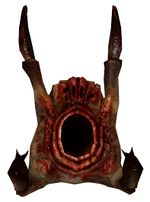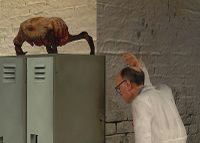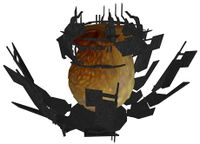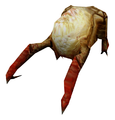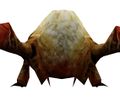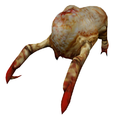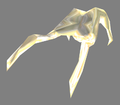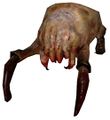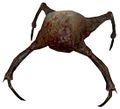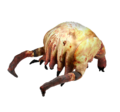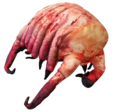Headcrab
This article is about the species. For the most common variation, see Classic Headcrab. |
| This article would greatly benefit from the addition of one or more new images. | ||
|---|---|---|
Please upload one or several relevant images (from canonical / official sources) and place it here. Once finished, this notice may be removed. |
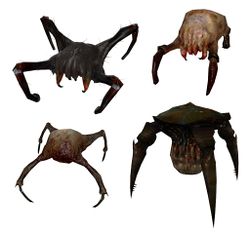
| |
| Headcrab | |
|---|---|
| General information | |
| Faction |
Xen wildlife |
| Type |
Parasite |
| Game information | |
| Entity |
|
| Designer(s) | |
- "Have you ever seen such a magnificent species? These crabs can completely control their hosts' nervous system. Can you imagine what the next stage of mutation looks like?"
- ― Black Mesa scientist[src]
Headcrabs, often called "headhumpers" (or "head-humpers") by Barney Calhoun and "parasitics" by the Combine Overwatch, are the most numerous, and arguably the most iconic, aliens of the Half-Life series, serving as a mascot in the same vein as Gordon Freeman and his Crowbar.
Contents
Overview[edit]
Headcrabs are fairly small creatures, roughly the size of a pumpkin, which crawl on four legs, and have enough jumping power to leap up to 10 feet (3 meters) in any direction. Their underbelly is almost completely covered by a large, lipless mouth with a hidden "beak" used for feeding and latching onto the skulls of victims. (see below)
As seen on Xen in Half-Life, Headcrabs appear to typically be born out of Gonarchs, therefore some Headcrabs may evolve into Gonarchs, and never use a host.
Headcrabs were studied at Black Mesa, notably in the Advanced Biological Research Lab and the Gamma Labs.
During the Combine occupation of Earth, Headcrabs appear to have no external sensory organs, including eyes or ears, though the original Headcrab model in Half-Life had three eyes on each side of its body.
The Classic Headcrab can also be seen burrowing in and out of the ground, but not the other species.
Headcrabs can, apparently, be domesticated, as shown by Lamarr, Isaac Kleiner's pet Headcrab, who has been "de-beaked", and is said to be "completely harmless." Thus, removing the beak of Headcrabs renders them unable to perform their normal function of taking over humans, rendering them harmless and apparently less aggressive.
It appears that the flesh of both Standard and Fast Headcrabs is edible, at least for Vortigaunts. The former can be seen being prepared by Vortigaunts in Black Mesa East while the latter can be seen being roasted by the Singing Vortigaunt.
Types[edit]
The Headcrab comes in several known variations:
- The Classic Headcrab - the first Headcrab introduced in Half-Life, seen in its infant form near the end of the game. It turns its host into a Classic Zombie, and in some cases a Gonome.
- The Gonarch - a much larger, mature form of Headcrab which spawns baby Headcrabs. Does not use hosts.
- The Fast Headcrab - introduced in Half-Life 2, and much faster than Classic Headcrabs. Turns its host into a Fast Zombie.
- The Poison Headcrab - a toxic Headcrab, causing more damage to the host. Also introduced in Half-Life 2, it turns its host into a Poison Zombie.
- The Armored Headcrab - a more fragile Headcrab that carries a hardened shell capable of protecting it even from gunfire. However, if the glowing heart on its underside gets shot, it will break apart instantly.
- The Reviver - a fast and agile Headcrab that, aside from being able to shoot electric balls, has the ability to electrically reanimate dead bodies, turning its host into a Revived Zombie.
Zombification[edit]
Headcrabs are a parasitic species, attaching to the host's head and clamping onto their skull using their sharp beak. After breaking through the skull, the Headcrab proceeds to take over its host's motor functions through some unknown biological process, keeping its host alive but helpless through the entire process. As seen in Station 6 in Half-Life 2, it seems to take from several seconds to minutes for a Headcrab to turn humans into Zombies. Headcrabs aren't known to be able to turn Xenian creatures such as Vortigaunts into Zombies, this implies that the original host species in the Headcrab's homeworld is similar enough to a human for the hosting strategy to be effective in humans.
The host appears to retain partial consciousness once the Headcrab has taken control, as Classic Zombies and Zombines retain a certain ability to talk.
Each Headcrab variation affects its host in its own way, producing a Zombie extremely distinct from the other types in both appearance and behavior.
Combine application[edit]
In Half-Life 2, the Earth-occupying Combine is seen utilizing Headcrabs as a form of biological weaponry against the Resistance. "Headcrab Shells", as they are known, are large mortar shells containing a payload of Headcrabs, which are released on impact, free to infect or terrorize anyone nearby. If used in large numbers, these shells are highly effective in neutralizing a large Resistance base. The effects of large-scale Headcrab shelling are seen during Gordon's visit to the devastated town of Ravenholm, where most inhabitants have been turned into Zombies.
In Episode One it seems that the Combine have begun to lose control over their bio-weapon; Headcrabs begin infecting Combine Soldiers, showing that the large-scale effects of shelling have caused even Combine-controlled areas to be affected.
Related Achievements[edit]
| Half-Life: Alyx | |
|---|---|

|
Sustenance |
| Receive a tasty treat. | |

|
Freshly Squeezed |
| Test your grip on a headcrab heart. | |

|
Crustacean Frustration |
| Kill the annoying headcrab before it breaks everything. | |
Behind the scenes[edit]
Originally, a device holding a Gonarch's sack, nicknamed the "Combine Big Momma Pod" a reference to the Gonarch's nickname, was to be used by the Combine for obtaining large numbers of Headcrabs for use in Headcrab Shells,[2] and to be encountered in the Ravenholm mine.[2] Since the device does not appear in the final games, it is unknown so far how the Combine breeds their Headcrabs.
In Half-Life: Alyx there are several Xen props called "Headcrab Clusters". They are typically bumpy shapes with several mouth like protrusions that "breathe". They also occasionally make very muffled Headcrab idle sounds. They are also typically found in Headcrab infested areas. When viewed in a model viewer they are displayed upside down with their "roots" on the ceiling. This forms a shape very similar to the "sack" underneath the Gonarch.[source?]
Gallery[edit]
Half-Life and its expansions[edit]
Classic Headcrab model, with six eyes (Half-Life version).
Gonarch model.
Half-Life 2 and its Episodes[edit]
Fast Headcrab model.
Poison Headcrab model.
Half-Life: Alyx[edit]
Armored Headcrab model.
Reviver model.
Other[edit]
List of appearances[edit]
Main games[edit]
- Half-Life
- Half-Life: Opposing Force
- Half-Life: Blue Shift
- Half-Life: Decay
- Half-Life 2
- Half-Life 2: Episode One
- Half-Life 2: Episode Two
- Half-Life: Alyx
Other[edit]
- Half-Life: Day One (First appearance)
- Half-Life: Uplink (Non-canonical appearance)
- Half-Life 2: Raising the Bar
References[edit]
- Good articles
- Articles needing one or more images
- Articles with unsourced statements
- Half-Life
- Half-Life: Opposing Force
- Half-Life: Blue Shift
- Half-Life: Decay
- Half-Life: Uplink
- Half-Life 2
- Half-Life 2: Lost Coast
- Half-Life 2: Episode One
- Half-Life 2: Episode Two
- Recurring themes
- Headcrabs
- Enemies
- Ted Backman designs
- Half-Life 2: Raising the Bar
- Xen creatures
- Creatures
